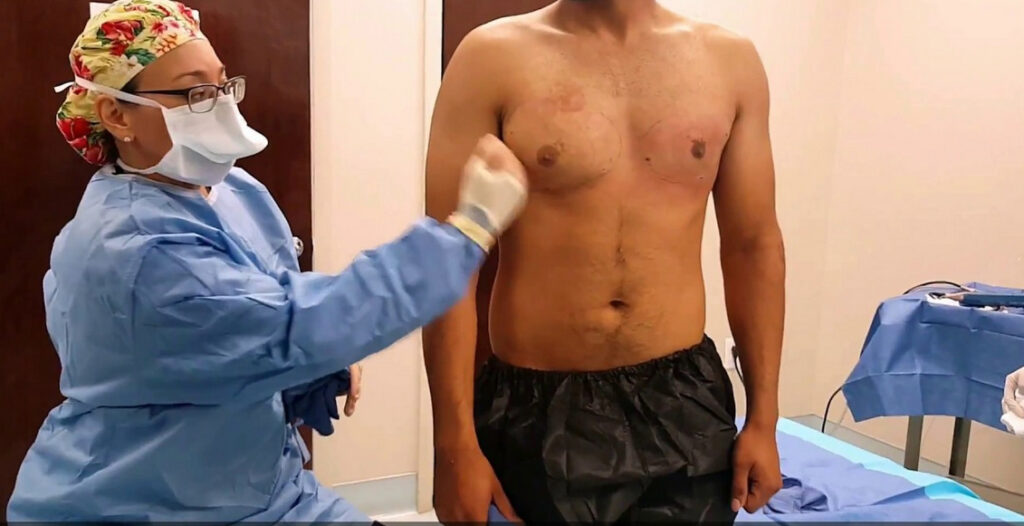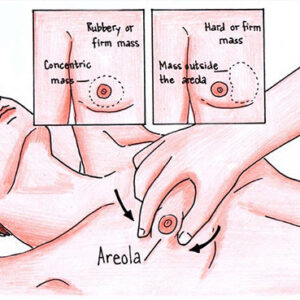Male breast reduction surgery is a popular procedure that can help to correct gynecomastia, a condition characterized by the abnormal development of breast tissue in males. While many people with gynecomastia are able to live with the condition without experiencing any major health issues, others may experience physical discomfort or emotional distress as a result. If you’re considering male breast reduction surgery to address gynecomastia, it’s important to prepare properly. In this article, we’ll explore 9 tips to help you get ready for your surgery and make the most of your recovery period.

Tips to Prepare For Male Breast Reduction Surgery
1. Research Your Options
Before undergoing male breast reduction surgery, it’s important to do your research and find a qualified plastic surgeon who has experience performing the procedure. Look for a surgeon who is board-certified and has a track record of successful surgeries.
During your consultation with a plastic surgeon, be sure to ask about their experience with male breast reduction surgery specifically. You should also ask about the different surgical techniques available, and the pros and cons of each approach.
Before you even continue, you may first consider trying supplements that are highly designed for burning chest fat and reducing gynecomastia. Gynetrex is a chest fat-burning supplement that has proven effective for many men. It’s a complete system that combines exercise, nutrition, and a powerful fat-burning supplement to deliver quick, effective results.

Gynetrex is designed by fitness and nutrition experts, and it offers a strategic, systematic plan to burn excess chest fat using a tried-and-tested, scientifically-proven method. By exercising regularly and eating a balanced, healthy diet, you can reduce the size of your chest and decrease your overall body fat. Learn more from their official website
When you combine these lifestyle changes with the Gynetrex daily fat-burning supplement, you’ll see even more accelerated results. To see results, it’s important to be patient, focused, and consistent with your workouts, nutrition, and supplementation. Commit to the system, follow the plan, and see results. By reducing your chest size, decreasing your body fat, and increasing your lean muscle mass, you can improve your health, happiness, and confidence. Check Chest Fat Vs Gynecomastia: The Best Chest Fat Burning Supplement
2. Get a Medical Evaluation
As with any surgical procedure, it’s important to get a medical evaluation before undergoing male breast reduction surgery. Your doctor will want to make sure that you’re in good overall health and that there aren’t any underlying medical conditions that could put you at risk during surgery.

Be prepared to provide a full medical history and to undergo any necessary lab tests or other evaluations. If you take any medications regularly, make sure to disclose this information to your doctor, as you may need to adjust or stop taking certain medications prior to surgery.
3. Make Arrangements at Work
Plan for time off from work after surgery. Most patients need between one to two weeks of downtime to rest and recover. Ask your surgeon for guidance on when you can expect to return to work.
4. Prepare for Recovery
Male breast reduction surgery is generally considered to be a low-risk procedure, but you’ll still need to take some time off from work and other activities to recover properly. Make sure you have a plan in place for your recovery period, and arrange for someone to help you out if necessary.
You may need to take a few days or even a week off from work following your surgery, depending on your individual recovery needs. You’ll also need to avoid any strenuous activities that could put stress on your chest muscles or incisions, so plan to take it easy for a while.
5. Maintain a Healthy Lifestyle
Leading a healthy lifestyle can help to ensure a successful surgery and speedy recovery. In the weeks leading up to your procedure, focus on eating a nutritious diet, staying well-hydrated, and getting plenty of rest.
If you smoke, you’ll need to quit prior to your surgery, as smoking can interfere with the healing process and increase your risk of complications. Losing weight may also be necessary for some patients, as excess body fat can contribute to the development of gynecomastia.
6. Follow Pre-Surgery Instructions
Your plastic surgeon will likely provide you with a set of pre-surgery instructions to follow in the days and weeks leading up to your procedure. These instructions may include dietary restrictions, medication adjustments, and other precautions.
Be sure to follow these instructions closely, as they can help to ensure a safe and successful surgery. If you have any questions or concerns about the instructions, don’t hesitate to contact your plastic surgeon for clarification.
7. Prepare Your Home
Before your surgery, it’s a good idea to prepare your home to make your recovery period as comfortable as possible. This may include setting up a recovery area with pillows and blankets, stocking up on healthy snacks and drinks, and arranging for someone to help with household tasks.
You’ll also need to make sure you have any necessary post-surgery supplies, such as surgical dressings and compression garments. Your plastic surgeon will likely provide you with a list of supplies to purchase in advance.
8. Arrange for Transportation
It’s important to have someone who can drive you to and from the surgery center on the day of your surgery. You won’t be able to drive yourself home after the procedure because you’ll be under the influence of anesthesia, and it’s not safe to drive or operate machinery in this state. You can ask a family member or friend to take you home, or arrange for a taxi or ride-share service to pick you up.

9. Plan for Post-Op Care
After male breast reduction surgery, you’ll need to take care of yourself properly to ensure that your recovery is smooth and uneventful. Your surgeon will give you specific post-op instructions to follow, but you can also make plans ahead of time to make the recovery process easier. For instance, you may need to have someone to help you with household chores, cooking, and running errands while you recover.
Most Searched Questions about Male Breast Reduction Surgery
How is male breast reduction surgery performed?
Male breast reduction surgery, also known as gynecomastia surgery, involves the removal of excess breast tissue, fat, and skin from the chest area in order to create a more masculine appearance. The procedure is usually performed under general anesthesia and may take between 1-3 hours to complete.
There are several techniques that can be used in male breast reduction surgery, depending on the severity of the gynecomastia and the amount of tissue that needs to be removed. The most common technique involves making a small incision around the areola, through which excess tissue and fat can be removed. In some cases, liposuction may also be used to remove excess fat from the chest.
Is male breast reduction surgery covered by insurance?
In most cases, male breast reduction surgery is considered a cosmetic procedure and is not covered by insurance. However, if the gynecomastia is causing significant physical symptoms, such as pain or discomfort, insurance may cover the cost of the surgery. It is important to check with your insurance provider to see if you are eligible for coverage.
What are the risks and complications of male breast reduction surgery?
Like any surgical procedure, male breast reduction surgery carries some risks and potential complications. These may include bleeding, infection, scarring, asymmetry, nerve damage, and an adverse reaction to anesthesia. It is important to discuss the risks and potential complications with your surgeon before the procedure.
How long is the recovery time for male breast reduction surgery?
Recovery time for male breast reduction surgery varies depending on the extent of the procedure and the individual patient. Most patients can return to work and normal activities within 1-2 weeks, but strenuous exercise and heavy lifting should be avoided for at least 4-6 weeks following the surgery.
Will there be scarring after male breast reduction surgery?
Scarring is a common side effect of any surgery, including male breast reduction surgery. However, the extent of scarring depends on the technique used in the surgery and the individual’s healing process. In most cases, scarring is minimal and fades over time.
Who is a good candidate for male breast reduction surgery?
Men who are in good physical health, have realistic expectations, and are bothered by the appearance of excess breast tissue and fat are good candidates for male breast reduction surgery. Candidates should also have tried non-surgical options, such as exercise and weight loss, but have not seen significant improvement.
How long does the procedure take for male breast reduction surgery?
The duration of the procedure for male breast reduction surgery varies depending on the technique used and the amount of tissue that needs to be removed. In general, the procedure takes 1-3 hours to complete.
How much pain is involved in male breast reduction surgery?
Some discomfort and pain are to be expected following male breast reduction surgery, but it can be managed with pain medication. Most patients report feeling soreness and tightness in the chest area for a few days following the surgery.
Are the results of male breast reduction surgery permanent?
The results of male breast reduction surgery are generally permanent, but weight gain, hormonal changes, and other factors may cause gynecomastia to return. Maintaining a healthy weight, exercising regularly, and avoiding hormone-altering substances can help to ensure the long-term success
How soon after male breast reduction surgery can I return to work?
This depends on the extent of the surgery and the type of work you do. If your job is not physically demanding, you may be able to return to work within a week or two. However, if your job involves heavy lifting or other strenuous activity, you may need to take several weeks off to allow for proper healing.
Can I exercise after male breast reduction surgery?
It is important to avoid any strenuous activity, including exercise, for at least a few weeks after male breast reduction surgery to allow for proper healing. Once your surgeon has given you clearance to resume physical activity, you can gradually return to your normal exercise routine.
Can male breast reduction surgery improve my posture?
Yes, in some cases, male breast reduction surgery can improve posture by reducing the weight and size of the chest. This can also alleviate any discomfort or pain associated with poor posture.
What kind of follow-up care will I need after male breast reduction surgery?
Your surgeon will provide specific instructions on how to care for your incisions, manage pain, and monitor your progress after male breast reduction surgery. Follow-up appointments will also be scheduled to ensure proper healing and address any concerns or complications that may arise.
Male Breast Reduction Surgery: Final Thoughts
Male breast reduction surgery is an effective solution for men who are struggling with gynecomastia. By following these tips to prepare for the procedure, you can help ensure that your surgery goes smoothly and your recovery is quick and easy. Remember to choose a board-certified plastic surgeon, get a lab test and medical evaluation, follow a healthy lifestyle, and arrange for post-op care to make the most of your procedure. If you’re considering male breast reduction surgery, schedule a consultation with a qualified surgeon to learn more about your options and get started on the path to a better-looking, more confident you.



